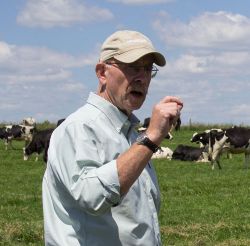
Using a front-end loader, Ray lifted the two tires filled with concrete into the back of his two-wheel drive pickup truck. This would help with traction while pulling the forage wagon uphill on the road. As I was soon to find out, the added weight offered little value going downhill.
Many years ago, before the days of portable or drive-over scales, the only way to accurately calculate on-farm alfalfa yield was to harvest a premeasured field area and then pull the wagon of bales or haylage to the nearest gravel pit or grain elevator scale. In Ray’s situation, it was haylage, specifically a forage box full of wet, chopped alfalfa.
Pickup trucks in those days were generally not the four-wheel drive beasts common on many farms today. No, most farm owners were still recovering from the early ‘80s economic farm crisis and considered functional exhaust systems and solid floorboards as optional equipment. Still, we needed to pull a loaded forage box from Point A to Point B. Between those two dots was Hill C with a slope approaching that of a big boy’s waterslide — only much longer.
There was also one further obstacle . . . a stop sign sat at the bottom of the hill where the road ended at a state highway. It was going to be a bit dicey, but this was back forty forage research at its finest.
As we descended the hill, I watched the road run beneath us through the rusted floorboards. Ray pumped the brakes, keeping our speed to below the legal limit.
Nearing the bottom and approaching the stop sign, Ray asked, “Do you see anything coming from your direction?”
My eyes lifted from the floorboard, but before I could say anything Ray retracted his inquiry, “It doesn’t matter . . . we can’t stop anyway.”
He was right; several laws of physics and a well-worn truck were working against us. We didn’t stop and somehow managed to make the turn with forage box still in tow. It was either pure luck or divine intervention that cross-traffic timing was in our favor on that day.
Documenting forage yield per acre of the accurate ilk has always been an elusive number outside of small-plot research. Yield, however, remains a key profitability metric. Typically, it costs as much to harvest a low-yielding crop as it does a high-yielding one. That means your unit margin is significantly greater for the latter. It’s unfortunate that it’s such a hard thing to measure.
Of even greater consequence is the fact that forage yield can’t stand alone. Feed quality must also be considered. The yield-quality trade-off has long haunted the forage grower. Even our company’s founder, W.D. Hoard, recognized the need to cut alfalfa before the point of maximum yield. That was more than a century ago.
Slowly, but surely, this problem is getting fixed. From a yield-measuring perspective, on-board monitors are now available for choppers and balers. More farms also have their own drive-over scales.
From a yield enhancement perspective, we look to our forage breeding industry. There we see not just higher yielding varieties than days gone by, but also ones with much less of a quality trade-off at more impressive and profitable yield levels.
My days of hauling loads of forage to the nearest scale are over, but always striving for added forage yield with high quality remains a deserving goal of every forage grower’s attention.
This article appeared in the November 2017 issue of Hay & Forage Grower on page 4.
Not a subscriber? Click to get the print magazine
